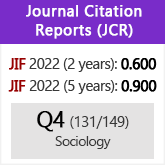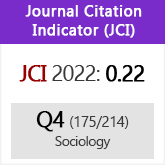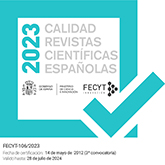A comparison of two modes of data collection. Using multidimensional analysis
DOI:
https://doi.org/10.3989/ris.2011.02.07Keywords:
Electoral surveys, Face to face survey, Mixed mode surveys, Multiple Correspondence Analysis, Telephone surveyAbstract
Although the literature on survey modes had abandoned comparisons between face-to-face and telephone surveys, having concluded that the results are similar, the current technological and social environment calls for resuming the debate. As well as the problems that arise when the prospective respondent does not own a telephone (or problems accessing mobile phone users), it is also important to bear in mind that a telephone survey places the respondent in a completely different social situation from that of a face-to-face interview. This gives rise to major differences in the responses to surveys where the interviewer is present (face-to-face) and those conducted via telephone. Although numerous studies have analysed this phenomenon, the vast majority of them have used “variable to variable” comparisons, and hence present the inevitable shortcomings of univariate and bivariate analysis. The present study takes a fresh approach, in which all the survey variables are considered jointly using Multiple Correspondence Analysis on a 2005 regional election poll conducted in Galicia, Spain, by the Center for Sociological Research (CIS) (survey number 2.608).
Downloads
References
Abascal, E. and Grande, I. 2005. Análisis de Encuestas. Madrid: ESIC.
Abascal, E.; Díaz de Rada, V. García-Lautre, N. and Landaluce, M. “Comparing face to face and telephone surveys in terms of sampling representativeness: a multidimensional analysis. ” Quality & Quantity. International Journal of Methodology. junio 2010.
Alvira Martín, F. 2004. La encuesta: una perspectiva general metodológica. Madrid: CIS, Cuadernos Metodológicos, nº 35.
Beck, F., Legleye, S., Peretti-Watel, P. 2004. “Using the telephone in general population surveys on drugs”. Pp. 113-140. In T. Decorte and D.J. Korf (Eds.), European studies on drugs and drug policy. Brussels: VUB Press.
Benzécri J.P. 1979. “Sur le calcul des taux d´inertie dans l´analyse d´un questionnaire”, Les cahiers de l´Analyse des Donnés vol. 4, nº 3, pp. 377-366.
Biemer, P.P. 2001. “Non-response bias and measurement bias in a comparison of face to face and telephone interviewing”, Journal of Official Statistics, Vol.17, pp. 295-320.
Blumberg, S.J.; Luke, J.V.; Cynamon, M.L. and Frankel, M. 2008. “Recent trends in household telephone coverage in the United States”. Pp. 26-86. In J. Lepkowski et al. (Eds). Advances in telephone survey methodologies. New York: Willey, 56-86 (2008).
Bowers, J. and Ensley, M.J. 2003. Issues in Analyzing Data from the Dual-Mode 2000 American National Election Study, NES Technical Report.
Centro de Investigaciones Sociológicas 2005. Preelectoral de Galicia. Elecciones autonómicas 2005, Madrid: Centro de Investigaciones Sociológicas, research number 2608.
Czaja, R. y Blair, J. 1996. Designing Surveys. California: Pine Forge.
Day, N.A. et al. 1995. “Maximizing response to surveys in health-program evaluation at minimum-cost using multiple methods”, Evaluation Review, Vol.19, pp. 436-450. http://dx.doi.org/10.1177/0193841X9501900405
De Leeuw, E. and Van der Zouwen, J. 1988. “Data quality in telephone and face to face surveys: a comparative meta-analysis”. Pp. 283-299, in R.M. Groves et al. (eds), Telephone Survey Methodology, New York: Wiley.
De Leeuw, E. 2008. “Choosing the method of data collection”. Pp. 113-135, in E.D. de Leeuw; J.J. Hox y D.A. Dillman (eds.). International Handbook of Survey Methodology. Nueva York: Lawrence Erlbaum Associates y Asociación Europea de Metodología, pp. 113-135.
Dillman, D.A. 2008. “The logic and psychology of constructing questionnaires”. Pp. 171-175 in E.D. de Leeuw; J.J. Hox y D.A. Dillman (eds.). International Handbook of Survey Methodology. Nueva York: Lawrence Erlbaum Associates y Asociación Europea de Metodología.
Ellis, C. and Krosnick, J.A. 1999. Comparing telephone and face to face surveys in terms of sample representativeness: a Meta-Analysis of Demographics Characteristics. Ann Arbor, University of Michigan: NES (National Election Studies) Technical Reports. Retrieved March 1, 2005 from: www.umich.edu/<nes/resources/papers/papers.htm.
Galán, I.; Rodríguez Artalejo, F. and Zorrilla, B. 2004. “Comparación entre encuestas telefónicas y encuestas “cara a cara” domiciliarias en la estimación de hábitos de salud y prácticas preventivas, Gaceta Sanitaria, vol.18, nº 6, pp. 440-50. PMid: 15625042
Goyder, J. 1985. “Face to Face Interviews and Mailed Questionnaires: The Net Difference in Response Rate”, Public Opinion Quarterly, vol. 49, pp. 234-252. http://dx.doi.org/10.1086/268917
Green, M.C., Krosnick, J.A. and Holbrook, A.L. 2001. “The survey response process in telephone and face-to-face surveys. Differences in respondent satisficing and social desirability response bias. Retrieved June 23, 2004 from: www.umich.edu/<nes/resources/techrpts/tech-abs/tech-ab62.htm.
Grenacre M.J. and Blasius, J. (eds) 2006. Multiple Correspondence Analysis and Related Methods. London: Chapman & Hall / CRC.
Groves, R.M. 1989. Survey Error and Survey Cost. New York: Wiley. http://dx.doi.org/10.1002/0471725277
Groves, R.M y Kahn, R. 1979. Surveys by Telephone. New York: Academic Press.
Hox, J.J. and Deleeuw, E. 1994. “A Comparison of Non-response in Mail, Telephone, and Face-to-face Surveys”, Quality and Quantity, Vol. 28, pp. 329-344. http://dx.doi.org/10.1007/BF01097014
Kalton, G. 2000. “Developments in survey research in the past 25 years.” Survey Methodology, vol. 26, nº 1, pp. 3-10.
Krosnick, J.A. 1991. “Response strategies for coping with the cognitive demands of attitude measures in surveys”, Applied Cognitive Psychology, vol. 5, pp. 213-236. http://dx.doi.org/10.1002/acp.2350050305
Krosnick, J.A. 1999. “Survey research”, Annual Review of Psychology, vol. 50, pp. 537-567. http://dx.doi.org/10.1146/annurev.psych.50.1.537 PMid: 15012463
Kuusela, V.; Callegaro, M. and Vehovar, V.: The influence of mobile telephones on telephone surveys. In J. Lepkowski et al. (Eds). Advances in telephone survey methodologies. Willey, New York, 87-112 (2008).
Lavrakas, P.J. 1993. Telephone Survey Methods. Newbury Park, CA: Sage, Applied Social Research Methdods Series, vol 7.
Lebart L.; Morineau, A: and Piron M. 1998. Statistique exploratoire multidimensionelle. Paris: Dunod Martínez de Luna, I. 2008. “Encuestas de opinión: de la teoría a la práctica”, Metodología de encuestas, vol. 10, 7-26.
Massey, J.T. 1988. “An overview of telephone coverage” Pp. 3-8 in R.M. GROVES et al., Telephone Survey Methodology. New York: Wiley.
Méndez Lago, M. and Martínez Casinello, R. 2007. Encuestas telefónicas vs. presenciales: análisis de la encuesta pre-electoral del CIS de las elecciones gallegas de 2005. 15th Seminar on Political and Sociological Surveys, organized by the Spanish Association for Opinion, Marketing and Market research studies (AEDEMO), Madrid, 15-16 November 2007.
Nicolaas, G.; Thomson, K. and Lynn, P. 2000. The feasibility of conducting Electoral Surveys in the UK by telephone, London, National Centre for Social Research.
Presser, S. and Stinson, L. 1998. “Data collection mode and social desirability bias in self-reported religious attendance”, American Sociological Review, Vol.63, pp. 137-145. http://dx.doi.org/10.2307/2657486
Salinas, J.M.; Calvo, A. and Aguilar, M.C. 2004. “Un análisis comparativo entre la entrevista telefónica y la entrevista presencial en la determinación de la prevalencia de los juegos de azar”, Metodología de Encuestas, vol. 6, nº 2, pp. 119-132.
Sykes, W. and Collins, M. 1998. “Effects of Mode of Interview: experiment in the UK”, in R.M. Groves et al. (eds), Telephone Survey Methodology, New York, Wiley, pp. 283-299.
Tourangeau, R. 2004. “Survey Research and societal change”, Annual Review of Psychology, vol. 55, pp. 775-801. http://dx.doi.org/10.1146/annurev.psych.55.090902.142040 PMid: 14744234
Voogt, R.J.J. and Saris, W.E. 2005. “Mixed Mode Designs: Finding the Balance Between Nonresponse Bias and Mode Effects”, in Journal of Official Statistics, Vol.21, No.3, pp. 367-387.
Wessell, D.; Rahn, W and Rudolph, T. 2000. An analysis of the 1998 NES Mixed-Mode Design. Ann Arbor, University of Michigan: NES (National Election Studies) Technical Reports. Retrieved March 1, 2005 from: www.umich.edu/~nes/resources/papers/papers.htm.
Willems, P. y Oosterveld, P. 2003. “The best of both worlds”, Marketing Research, pp. 23-26.
Downloads
Published
How to Cite
Issue
Section
License
Copyright (c) 2012 Consejo Superior de Investigaciones Científicas (CSIC)

This work is licensed under a Creative Commons Attribution 4.0 International License.
© CSIC. Manuscripts published in both the printed and online versions of this Journal are the property of Consejo Superior de Investigaciones Científicas, and quoting this source is a requirement for any partial or full reproduction.All contents of this electronic edition, except where otherwise noted, are distributed under a “Creative Commons Attribution 4.0 International” (CC BY 4.0) License. You may read here the basic information and the legal text of the license. The indication of the CC BY 4.0 License must be expressly stated in this way when necessary.
Self-archiving in repositories, personal webpages or similar, of any version other than the published by the Editor, is not allowed.

















